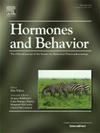Maternal immune activation during the lactational period alters offspring behavior, reproductive development, and immune function in mice
IF 2.4
3区 医学
Q2 BEHAVIORAL SCIENCES
引用次数: 0
Abstract
Exposure to infection during early life can lead to lasting neurodevelopmental changes. Animal models of maternal immune activation (MIA) typically assess neurobehavioral alterations in offspring following a prenatal inflammatory challenge. However, MIA effects on offspring can extend to challenges that occur during the lactational period. In the present study, we adapted previous methods focused on rats and challenged nursing C57BL/6J mouse mothers on postnatal day (P)8 with either the bacterial mimetic lipopolysaccharide (LPS; 250 μg/kg, i.p.) or saline (control, i.p.). By exposing only the mother to LPS, this modeled a postpartum infection in the dam. Similar to the rat model, lactational MIA did not detrimentally alter maternal care but induced displays of maternal sickness, as expected. While neonatal offspring behaviors (e.g., huddling, ultrasonic vocalizations, negative geotaxis) were unaffected, significant effects of lactational MIA emerged in juvenile (e.g., social preference, accelerated reproductive milestones) and adult (e.g., mechanical allodynia, prepulse inhibition) offspring. In a separate set of animals, the developmental programming potential of lactational MIA on immune function was evident following a “second hit” LPS challenge in adulthood (e.g., altered plasma concentrations of interleukin-6 and leukocytes, including neutrophils, and lymphocytes). These findings confirm the generalizability of the lactational MIA model across species and highlight the importance of supporting caregiver health and wellness across the critical nursing period.
哺乳期母体免疫激活会改变小鼠后代的行为、生殖发育和免疫功能
在生命早期接触感染可能导致持久的神经发育变化。母体免疫激活(MIA)的动物模型通常评估在产前炎症挑战后后代的神经行为改变。然而,MIA对后代的影响可以扩展到发生在哺乳期的挑战。在本研究中,我们采用了以前的方法,以大鼠为研究对象,在出生后第8天(P)8天,用细菌模拟脂多糖(LPS);250 μg/kg,滴注)或生理盐水(对照组,滴注)。通过仅将母亲暴露于LPS,这模拟了大坝的产后感染。与大鼠模型类似,哺乳期MIA并没有对母性护理产生不利影响,但正如预期的那样,会引起母性疾病的表现。虽然新生儿后代的行为(如抱头、超声发声、负地向性)不受影响,但哺乳期MIA在幼年(如社会偏好、生殖里程碑加速)和成年(如机械异常性疼痛、脉冲前抑制)后代中出现了显著影响。在另一组动物中,哺乳期MIA对免疫功能的发育编程潜力在成年期“第二次攻击”LPS后是明显的(例如,白细胞介素-6和白细胞,包括中性粒细胞和淋巴细胞的血浆浓度改变)。这些发现证实了哺乳期MIA模型跨物种的普遍性,并强调了在关键哺乳期支持照顾者健康和健康的重要性。
本文章由计算机程序翻译,如有差异,请以英文原文为准。
求助全文
约1分钟内获得全文
求助全文
来源期刊

Hormones and Behavior
医学-行为科学
CiteScore
6.70
自引率
8.60%
发文量
139
审稿时长
91 days
期刊介绍:
Hormones and Behavior publishes original research articles, reviews and special issues concerning hormone-brain-behavior relationships, broadly defined. The journal''s scope ranges from laboratory and field studies concerning neuroendocrine as well as endocrine mechanisms controlling the development or adult expression of behavior to studies concerning the environmental control and evolutionary significance of hormone-behavior relationships. The journal welcomes studies conducted on species ranging from invertebrates to mammals, including humans.
 求助内容:
求助内容: 应助结果提醒方式:
应助结果提醒方式:


